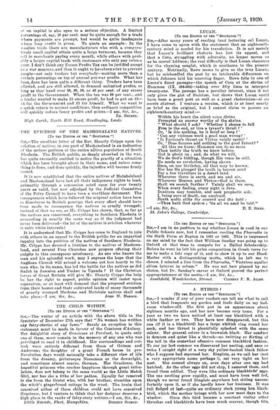A HYBRID ?
THE EDITOR 0* THE `}'Eterkesroa.°1 Sus, —I wonder if any of your readers can tell me what to call a bird that frequents ray garden and feeds daily on my bed- room window-sill. She firit put in an appearance about eighteen months ago, and has now become very tame. For a year or two we have noticed at least one blackbird with a white feather or two. They have now disappeared, but this one (if it is a blackbird) has a large whitish ring round her neck, and her threat is plentifully splashed with the same &dont% Her general colour is a brownish black. Her conduct is demure. and (pilot like a thrush—no twitting or flirting of ther tail iii the seniesehat offensive common blackbird fashion. To Out joy last summer we discovered her nesting, and once or twice I caught sight of a very shy yellow-beaked black fellow who I suppose had eimoused her. Ringlets, as we call her (not a very appropriate nanie perhaps I), sat very tight on her nest. She seemed always on, even days after one, egg had hatched, As the othereggs did not ship, I removed them, and found them addled. They were like-ordinary blackbird? eggs. The one nestling grew rapidly, and must have been well fed, though we never found Ringlets anywhere but sitting uncom- fortably upon it, as if she hardly knew her business. It was full fledged at laat—quite an ordinary sleek young hen black- biid, which the Mother brings with her now most days to the
window. Since this bird became a constant visitor other thrushes and blackbirds have been much scarcer, though tits, chaffinches, and robins feed happily with her. Can she be a cross between a blackbird and a ring ouzel, or between a black- bird and a song thrush P-1 am, Sir, ho., Parzan.
Sandybrook Hall, Ashbourne.











































 Previous page
Previous page